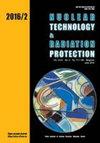与高场超导射频器件相关的增强场发射研究
IF 0.9
4区 工程技术
Q3 NUCLEAR SCIENCE & TECHNOLOGY
引用次数: 3
摘要
表面粗糙度表示表面上的不规则性对局部场增强的贡献。传统的针对完美平面建立的Fowler-Nordheim方程不适用于描述粗糙表面的发射。相反,使用描述表面形貌影响的场增强因子的方程更为合适。在超导射频腔中,场发射可以发生在虹膜中,并且腔表面的尖端可以作为导致高电场的发射器。在这项研究中,使用多物理场软件包COMSOL对半球形、圆柱形和锥形尖端进行了计算。重点研究了场增强因子对突出点形状和半径的依赖关系。由于腔虹膜处电场增强,电场强度和电流密度随轮廓高度均方根的增加而增加。电场的最低值已经在半球上得到了。场增强因子的计算值与文献数据一致,在这种情况下,突出可能代表超导腔表面的局部小凸起。在对所得结果拟合的基础上,提出了增强因子与半径的关系。场发射的准确估计对加速器的设计和其他精度要求很高的技术应用具有至关重要的作用。本文章由计算机程序翻译,如有差异,请以英文原文为准。
Studies of enhanced field emission relevant to high field superconducting radio frequency devices
Surface roughness represents the measure of the irregularities on the surface contributing to the local field enhancement. The traditional Fowler-Nordheim equation established for perfectly planar surfaces is not suitable for describing emission from rough surfaces. Instead, it is more appropriate to use the equation that accounts for the field enhancement factor describing the effect of the surface morphology. In superconducting radio frequency cavities field emission may occur in the irises and the tips on the cavity surface may act as an emitter leading to the high electric field. For this study, calculations for hemispherical, cylindrical, and conical tips have been performed by using a multiphysics software package COMSOL. The focus was put on the dependence of the field enhancement factor on the shape and the radius of the protrusions. The electric field strength and the current density increase with increasing the root mean square average of the profile heights due to field enhancement at the cavity irises. The lowest value of the electric field has been achieved for the hemisphere. The calculated values for the field enhancement factors are consistent with the data from the literature, in which case the protrusion may represent a small local bump on the surface of a superconducting cavity. Based on the fit of the results, presented here, the relation between the enhancement factor and the radius has been suggested. The accurate estimation of the field emission may play a crucial role in the design of accelerators and other technological applications with requirements of very high precision.
求助全文
通过发布文献求助,成功后即可免费获取论文全文。
去求助
来源期刊

Nuclear Technology & Radiation Protection
NUCLEAR SCIENCE & TECHNOLOGY-
CiteScore
2.00
自引率
41.70%
发文量
10
审稿时长
6-12 weeks
期刊介绍:
Nuclear Technology & Radiation Protection is an international scientific journal covering the wide range of disciplines involved in nuclear science and technology as well as in the field of radiation protection. The journal is open for scientific papers, short papers, review articles, and technical papers dealing with nuclear power, research reactors, accelerators, nuclear materials, waste management, radiation measurements, and environmental problems. However, basic reactor physics and design, particle and radiation transport theory, and development of numerical methods and codes will also be important aspects of the editorial policy.
 求助内容:
求助内容: 应助结果提醒方式:
应助结果提醒方式:


